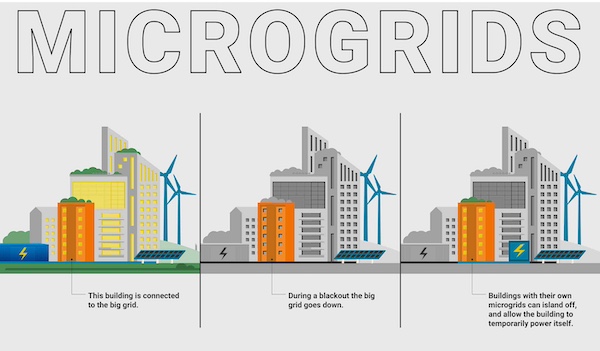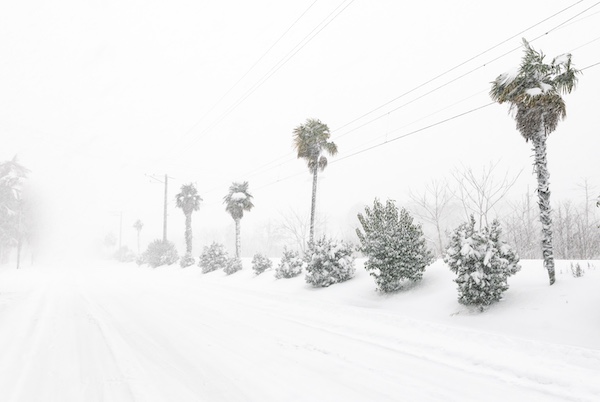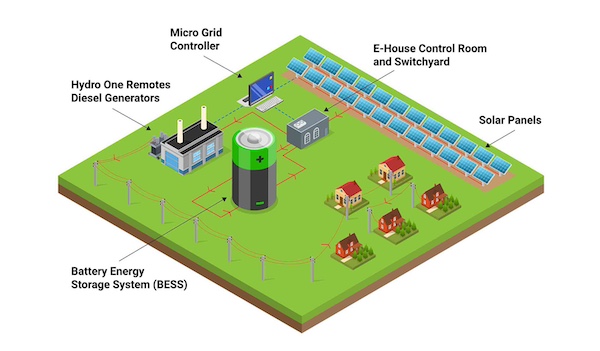Securing Our Energy Infrastructure with Microgrids
The impacts of climate change are becoming increasingly more apparent as communities around the world experience extreme weather events. From hurricanes and floods to droughts and wildfires, these types of events can have profound negatives effects on our energy infrastructure. This is a major challenge that will only continue to grow as the frequency — and severity — of these extreme weather events increases.
So, how can we protect our grid systems and promote energy security for those who need it? One good answer is implementing microgrids.

What are microgrids?
Microgrids are what they sound like: A small, self-sustaining local energy grid that exists within the larger grid system. A grid consists of power sources, users, wire connections, and a system to control everything. Microgrids consist of all that, they are just a smaller version of it. However, a defining element of a microgrid is its ability to connect and disconnect from the larger grid. This proves helpful during outages related to extreme weather events or system failures that can cause blackouts or brownouts.
Microgrids are becoming increasingly popular in achieving energy security because they provide power to customers during grid outages. They are also a growing segment of the energy transition, and represent the shift from centralized power towards more localized and distributed generation solutions. The aim? To protect communities, provide resiliency, and, in some cases, enable the transition to cleaner forms of energy.
Another great thing about microgrids is how they can pull power from distributed energy resources (a combination of different power sources). For example, a microgrid can have a baseload generation of electricity from traditional fossil-fuel sources. It can also include solar panels, wind turbines, and hydroelectric facilities. Furthermore, it can have battery energy storage systems to gather renewable energy when it’s generated, and discharge the energy when it’s needed. As we look to the future, microgrids may be able to utilize alternative energy solutions like hydrogen and small modular reactors. This makes them an attractive option for communities looking for energy security and making efforts to decarbonize.
Who can benefit from microgrids?
Everyone can benefit from microgrids, but they are especially useful in a couple of key settings. The first is rural and remote communities, which are generally serviced by long power lines that are vulnerable to disruption, if they are connected to the larger grid at all. Off-grid communities must generate power themselves. Traditionally, this has only been possible with fossil fuel resources. But microgrid solutions are increasingly enabling these communities to integrate renewables, which reduce their dependence on fossil fuels.
The second key benefit concerns essential services. Microgrids can provide resiliency for essential electrical systems such as those used by hospitals, data centers, and more. These institutions need to have power to operate 24/7, which is especially true during extreme weather events. There is a high-value proposition for these types of facilities to implement their own microgrids. If people are hurt or injured during a hurricane, for example, we need our hospitals to function in order to treat people in need. Furthermore, we need to make sure our communications systems are up and running during these events so emergency response teams can coordinate with each other — and the community — to achieve the best and safest outcomes.
It's clear that microgrids can benefit communities in need of solutions for energy security. To get a better perspective, let’s look at an example of what can happen when they don’t have one.

A case study in Texas
In February 2021, Winter Storm Uri swept through the southern United States. It had a profound impact on the state of Texas, causing record snowfall and low temperatures in the state that wasn’t necessarily prepared for the severity. This is because the grid there was not designed for these types of conditions. The result? A crisis of energy supply and demand.
During the winter storm, Texans were forced to turn up their thermostats to keep from freezing. Unfortunately, while the demand for electricity to heat homes was increasing, the ability to produce that electricity was waning; oil and gas pipelines froze, wind farms were iced over, and even nuclear power plants were taken offline due to the frigid conditions.
This resulted in several challenges for communities in Texas. More than 3.5 million Texans experienced power outages, leaving people without electricity to keep the lights on, heat their homes, or charge devices to keep in touch with loved ones and the local authorities. These power outages had knock-on impacts. Freezing temperatures and power disruptions affected water treatment facilities, which led to boil water notifications warning local residents to boil their water before drinking it to make sure it wasn’t contaminated. Power outages also strained fuel supplies as people collected fuel to run generators or were forced to stay warm in their cars. There were also food challenges as people were unable to cook their food or keep it fresh in the refrigerator.
Strategically deployed microgrids could have increased the resiliency for these communities. Not only could have safeguarded the water systems, but they could have ensured emergency facilities remained online, minimizing the impact to public transportation and safety.

Driving energy security with microgrids
As extreme weather events continue to grow in both quantity and severity, we need to prepare for the new normal. One of the best ways to do that is by protecting our power infrastructure. Microgrids can help us do that in a more resilient and sustainable way. Plus, they can help communities to diversify their energy sources and integrate renewables like wind, solar, hydropower, and more.
Microgrids should be increasingly more common as we drive the energy transition forward. Achievable for users big and small, microgrids are particularly effective in rural and remote communities. By adopting this sustainable energy solution, we can help to keep the lights (and heat!) on during extreme weather events.
Dane LaBonte is Business Development Analyst, Mike Voll is Principal, Sector Lead Smart Technologies, and Tony Zavanelli is Principal, Energy at Stantec. Stantec plans, designs, delivers and manages the development and infrastructure needed to support the creation of sustainable, healthy, and prosperous communities.
Stantec | www.stantec.com
Author: Dane LaBonte, Mike Voll, and Tony Zavanelli
Volume: 2024 May/June








